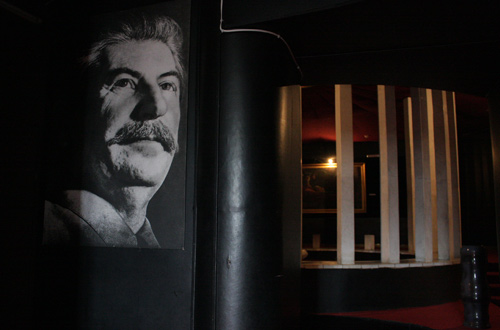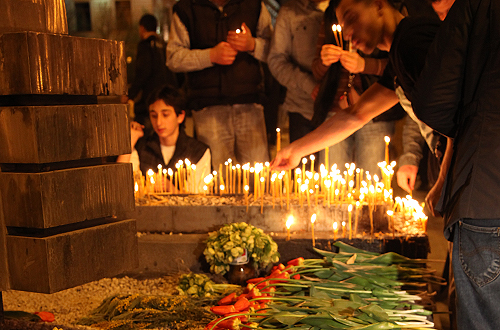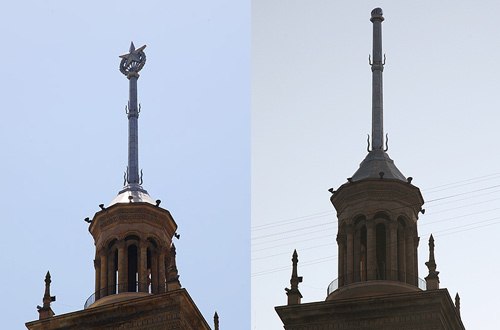| Transforming Museum of Stalin |
| Civil Georgia, Tbilisi / 9 Apr.'12 / 16:19 |

Stalin’s large photo seen in his museum in the town of Gori, next to a hall (on right) where the Soviet dictator’s death mask is exhibited. Photo: Civil.ge
The Joseph Stalin Museum in the Soviet dictator’s hometown of Gori in central Georgia will be transformed and renamed into Museum of Stalinism to focus on the Soviet regime’s repressions, Nikoloz Rurua, the minister of culture and monument protection, said on April 9.
A memorial house dedicated to Stalin was opened in Gori in 1937 in a small house where he was born; later a new complex was built for the museum which was opened in 1957, four years after the Soviet dictator’s death. The museum with its three sections chronicling Stalin’s life also includes the Soviet dictator’s personal railway carriage.
Renaming of the museum, which is one of the most popular tourist destinations in Georgia, signals change of its concept although details have yet to be elaborated. According to the Ministry of Culture a group of researchers would be established to develop the concept of the transformed museum, which would tell the story of the Stalinism “thoroughly and impartially.”
“The existing museum [of Stalin] is simply incompatible with our present day and most importantly with our future,” Culture Minister Nikoloz Rurua said on April 9 while visiting the museum in Gori.
“History can’t be erased and this very difficult page in history of our country, and not only of our country, requires to be appropriately displayed within these walls [of the museum],” he added.
The announcement was timed with the 23th anniversary of April 9 tragedy, when at least twenty people were killed as Soviet troops attacked peaceful protesters in Tbilisi in 1989.

Victims of the April 9 tragedy commemorated as people light candles and lay flowers at a predawn ceremony on Monday outside the Parliament building in Tbilisi on Rustaveli Avenue – the scene where at least twenty people were killed after the Soviet troops attacked peaceful protesters in 1989. Photo: Guram Muradov/Civil.ge
April 9, which is a public holiday in Georgia, also marks 21st anniversary of Georgia’s declaration of independence from the Soviet Union.
The announcement about renaming of the Stalin museum comes less than two years after the authorities removed six-meter bronze statue of Stalin, which was standing on a nine-meter pedestal in the center of Gori.
In 2006 Georgia opened in Tbilisi center the Museum of Soviet Occupation, exhibiting documents testifying repressions by the Soviet regime.

Compilation of two photos with left one, taken in June, 2011, showing a Soviet-old five-point star on top of a building housing the Georgian National Academy of Sciences in downtown Tbilisi and the right one, taken in December, 2011, showing the same scene in which there is no longer the Soviet-old star. Parliament passed on May 31, 2011 package of legislative proposals known as 'Liberty Charter', which among other things, also restricts public display of Soviet and Nazi symbols. Photos: Guram Muradov/Civil.ge
In 2010 the Georgian Parliament declared February 25 – the day when Bolshevik’s Red Army took over Tbilisi in 1921 – as the Day of Soviet Occupation marked by lowering of national flags to half-staff.
Also in 2010 the Georgian Parliament declared August 23 as the Day of Memory of Victims of Totalitarian Regimes – the decision echoing a declaration of the European Parliament on the proclamation of 23 August as European Day of Remembrance for Victims of Stalinism and Nazism.
